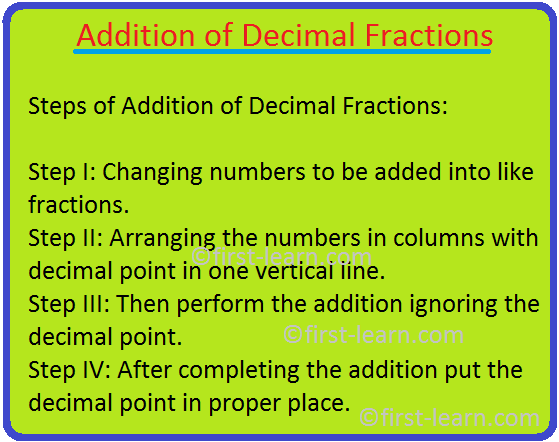Addition of Decimal Fractions
This topic will discuss on addition of decimal fractions. For adding decimal numbers we will have to first convert the decimals to be added into like decimals. Then we will write the decimal numbers in proper column so that the decimal point of every number falls in one vertical line in same location.
Steps of Addition of Decimal Fractions:
Step I: Changing numbers to be added into like fractions.
Step II: Arranging the numbers in columns with decimal point in one vertical line.
Step III: Then perform the addition ignoring the decimal point.
Step IV: After completing the addition put the decimal point in proper place.
For Example:
1. Add 19.625, 9.63, and 2.65
Changing the decimal fractions into like fractions such that:
19.625, 9.630, 2.650
Now we have to arrange these numbers in column keeping the decimal point in one vertical line
19.625
9.630
+ 2.650
31.905
In the thousandths column we get 5 + 0 + 0 = 5. Then in the hundredths column 2 + 3 + 5 = 10 but we will write 0 with 1 carrying in tenths column. In the tenths column 6 + 6 + 6 = 18 and add 1 carrying make it 19. So we write 9 in the tenths column and 1 carrying in units place. Now the addition in units place is 9 + 9 + 2 = 20 and 1 carrying from tenths place makes it 21. But we will write 1 in the units place and 2 carrying in the tens place. So the sum total of tens place is 3.
Here are few examples on addition of decimal fractions:
1. 5.01, 65.08, 96.369, 12.32
Changing the decimal fractions into like fractions such that:
5.010, 65.080, 96.369, 12.320
5.010
65.080
96.369
+ 12.320
178.779
In the thousandths column the sum total is 9 and there is no carryover. In the hundredths place the sum total is 1 + 8 + 6 + 2 = 17 where we write 7 in the hundredths place and 1 carryover in the tenths place. In the tenths place the sum total is 3 + 3 = 6 and 1 carryover making it 7. In the units place the sum total is 5 + 5 + 6 + 2 = 18 with no carryover. So we write 8 in the units place and 1 carryover in the tens place 6 + 9 + 1 = 16 and 1 carryover in the tens place.
2. 45.03, 65.032, 85.021, 25.02
Changing the decimal fractions into like fractions such that:
45.030, 65.032, 85.021, 25.020
45.030
65.032
85.021
+ 25.020
220.103
The sum total of thousandths place 2 + 1 = 3 with no carryover and the addition of hundredths place is 3 + 3 + 2 + 2 = 10. But we will only write 0 and 1 in the tenths place as carryover. The addition of the units place 5 + 5 + 5 + 5 = 20 and will write 0 in the units place with 2 as carryover, Lastly the addition of tens place is 4 + 6 + 8 + 2 = 20 and 2 as carryover making it 22.
From Addition of Decimal Fractions to HOME PAGE
Recent Articles
-
What Is Plasma? | Blood Plasma | Proteins | Nutrients | Cholesterol
Nov 07, 25 10:29 AM
Blood is a mobile fluid which is a connective tissue and is derived from the mesoderm like cell any other connective tissue. Colour of blood is reddish and that flows inside the blood vessels by means… -
Disorders of Respiratory System | Tuberculosis | Pleurisy | Emphysema
Oct 28, 25 11:39 PM
Tuberculosis is very common disease and is caused by a type of bacteria called Mycobacterium tuberculosis. This disease causes different trouble in the respiration and infection of several parts of th… -
Regulation of Respiration | Respiratory Centres | Inspiratory Area |
Oct 14, 25 12:13 AM
Respiratory Centre is the area that controls the rate of respiration and it is observed to be located in medulla oblongata and pons. Respiratory Centre has the following will dispersed components like… -
Explain Transport of Gases | External Respiration | Tissue Respiration
Oct 09, 25 11:35 PM
In humans gaseous exchange is completed in the following ways the steps are - External Respiration or Breathing - Breathing in false taking in of Oxygen and giving out of carbon dioxide in the body. M… -
Kind and Number of Teeth | Location of Teeth in Mouth | Care of Teeth
Sep 11, 25 12:52 AM
Kind and Number of Teeth






New! Comments
Have your say about what you just read! Leave me a comment in the box below.